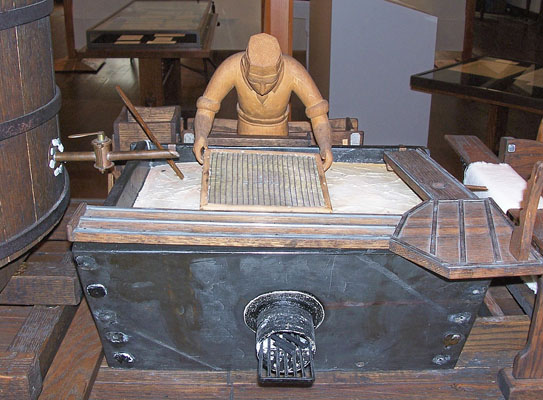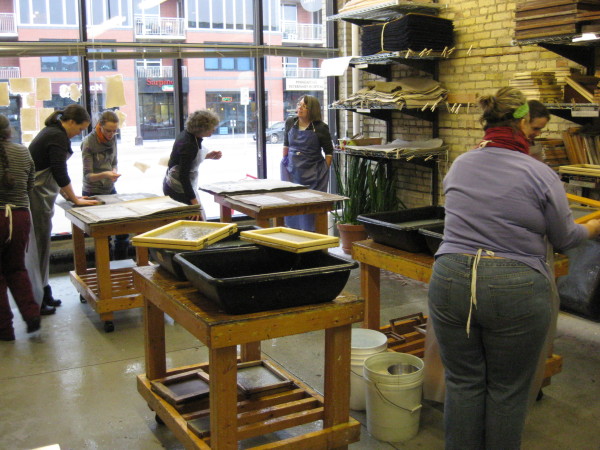Did Paper Come First?

A replica of Cai Lun, the man credited with the invention of papermaking in China.
I was talking with an esteemed colleague the other day, and she put something into words that has been bugging me for some time. She was at a celebration for a book arts organization and couldn’t help comparing our field (hand papermaking) with book arts. There are many established book arts programs around the country, there are libraries that specialize in artists’ books, there are book arts centers and hundreds of artists who call themselves book artists. And why, she pondered, isn’t it the same for paper, a field that became popular at about the same time? Since I am involved in both art forms, I’ve decided to ruminate on this.

The Crane Museum of papermaking in MA. Crane still makes 100% rag paper today.
But first, let’s set the stage: I’m not saying that paper isn’t respected. There are several colleges and universities with paper programs, and there are even paper museums (come to think of it, are there any book art museums)? These programs, in general, are part of other departments (this may be the case with many book art programs as well, but I’m pretty sure that there are many dedicated Book Art programs). There are libraries with paper collections, but I’d venture to say that the number of libraries is quite small in comparison to those that collect books (well, that seems obvious – libraries collect books, but I’m referring to artists’ books). There are also hundreds of paper artists (I’m a member of two organizations, each with 400+ members); Hand Papermaking Magazine is the journal for the field; and there are a variety of institutions dedicated to handmade paper, such as Dieu Donné Papermill in NYC and the Robert C Williams American Museum of Papermaking in Atlanta. There are also membership organizations: the Friends of Dard Hunter is a national organization, and IAPMA is international. Looking back at this list, I’m thinking WOW, we’ve come a long way!

Ok, so which came first? The chicken or the egg, I mean paper or books? I think it is obvious that paper came first, but I guess that depends on what you call a book, doesn’t it? Writing came before paper or books, so if the definition of a book includes the cave painting that depicts a story, perhaps the book did come first. But that is neither here nor there in the quest for the answer to my question: Why is book art more recognized than hand papermaking?
Here are some of my ideas, and I hope that you will add yours in the comments below!
Are books more accessible than paper? I have tried many tactics when introducing myself to non-artists. It always takes a few sentences, and I don’t think that there is a distinguishable difference in reaction when I introduce myself as a book artist or a paper artist. However, I do think that people can more easily understand that you can make a book (haven’t we all made some sort of book in school) than the fact that you can make a sheet of paper (I never made a sheet of paper in school, although I do think it is more prevalent today).
Have you seen this papermaking video on Sesame Street?
Is paper too versatile? Paper can be a substrate, a sheet in and of itself, a sculpture, a pulp painting, a book, an installation, and more. Perhaps, since it can be presented in so many ways, it isn’t going to become famous in and of itself.
Is paper too commonplace? The digital age aside, we use and touch paper more than we do books (not to mention that most books are made of paper). And let’s face it, paper is cheap and disposable; a book holds more perceived value. Paper is everywhere, so it becomes invisible.

Is it the craft vs art thing? I’d love to see a thought bubble for the people I tell that I make art with paper. I mean, what are they really thinking? I’m guessing that they are reminded of the handful of shredded recycled paper they put into a blender and made into a crude sheet of paper in grammar school. That is recycling, and yes its super cool, but it takes a bit more than that to educate someone about paper as an art form.

The paper studio at the Minnesota Center for Book Arts.
Is papermaking accessible? To make professional paper, you need specialized equipment. To a certain extent, this is true for book arts as well, but I think that the upfront papermaking costs are higher (a new Hollander beater, for example, runs $10,000). And in order to make paper, you need a suitable facility – one that can get wet. I often wonder what students of mine do after they leave me and the facility where I’m teaching. Many of them will will never make paper again.
I’ve spent my entire career trying to promote all levels of papermaking through my teaching, how-to books, exhibiting, placing my work in public spaces and public and private collections, and through social media, including this blog. I will continue to do this because I believe that paper is important in more ways than one!
And as you can see, I’m interested in the BIG (paper) PICTURE. I’ve just scratched the surface here. I’d love to hear your thoughts. Please leave a comment below!

7 Comments
Helen,
You raise many good questions and I think the answer is a combination of many things.
People are not aware of the history of paper in the east or the west and generally, people think of paper as something made from trees. At the Maker Faire in Colorado Springs last fall I had to gently correct most of the adults who came to my Maker Space and tell them no, the paper we were making was not made from trees but from other plant materials, including cotton rags, hemp, bamboo, iris leaves, pumpkin and more and that paper was not made from trees until about the 1850s. The common misconception is that paper has always been made from tree pulp in huge, polluting factories. Combine this misconception with the sentiment that paper is a throw away item and the problem of deforestation you have a perfect storm of misunderstanding.
Now, is papermaking an art or a craft? To me, it doesn’t really matter which label is applied but, when people ask me what I do and I say I’m a papermaker they say, “Oh.” What they envision is me stuffing torn pieces of junk mail into a blender on my kitchen counter for hours on end. Many artists have a hazy idea about hand papermaking on a larger scale. Many artists I know do not consider papermaking an art but a craft, and to them, craft is a dirty word. At a sale not long ago another artist said to me, “Your work is not really art, it’s craft, but it’s nicely displayed so it’s okay”. I was not sure how to respond so I simply smiled. For that sale, my work included flat paper, sculptural work and hand bound books.
To your point re equipment: Because papermaking equipment is so specialized and expensive and because papermaking studios are not a part of most school and college offerings people who may be interested have very limited opportunities to explore hand papermaking further. And frankly, most intro to hand papermaking classes in a papermaking studio using professional equipment is prohibitively expensive for most people. So, another perfect storm generated by the lack of papermaking facilities and high cost.
Changing perceptions will take slow, steady education when and where the opportunities arise. If we can reach out to people of all ages via demos, Maker Faires, and reduced cost workshops and let people get their hands wet and see what papermaking is all about I think the perceptions and misconceptions will change, but it will be a long, slow process.
I love paper and papermaking,I love everything about it and I love sharing it with others.
You have overwhelmed and warmed me at the same time with this recent stream of thought. You are a true paper artist. I will never be, my studio and life is spent else where but paper holds a place in my heart and in my hands daily….
We need education, and through you and other artist we can educate. I may not be a paper maker, but I can help to spread the word. I need to spend my time with people that can impart this info to me since my limited education only gave me bits and pieces.
Funny that we are discussing this piece of beauty as I tap tap on my pad…..I will read to my students your thoughts….
Thank you Helen.
Kate
Thanks, Kate! We are papermakers are small in number, so every voice helps. Sorry I didn’t see this comment until today! – Helen
Helen, You read my mind. Thank you for putting into words the quandary of “paper making”. I think the biggest drawback to papermaking is the cost of equipment,the space necessary to operate that equipment, an undefined marketplace and an uneducated and mis informed public.
In my “second life” project of creating a “professional” Paper Center here in Hawaii, I am up against all of the objections and misconceptions that we have all heard. Daily I find myself explaining about the hows and whys of paper. We had 2 visiting art scholars from Iran and they had no idea what kind of paper was used in their treasured creation myth the Shahnameh.
It is a lonely esoteric task…and we MUST keep at it…make more paper! Aloha,Allison
If I remember correctly from my History of the Book class (taught in a book arts program with a papermaking side to it, no less), the oldest form of the codex – the kind of book that is bound on one side with a spine and the reader pages through the book from one side to the other – has been traced to Ethiopia in the first century – roughly the same time Cai Lun is credited for inventing paper in China. The Ethiopian codices’ pages were either a form of papyrus or vellum, I can’t remember. But it seems to me the invention was roughly contemporaneous, although in different parts of the world. Of course, this is defining books a certain way, if you consider things like the Dead Sea scrolls, or Tibetan palm leaf books, etc, or proto-papers such as papyrus, parchment, tapa, amate, etc as a technology that papermaking developed from, it’s not so cut and dry.
I often wonder why papermaking as an art form/craft form does not also include a discussion of it as a form of science, as well. We (papermakers), take this plant matter of some form, and transform it through chemistry and hydrogen bonding into something. Here in the Bay Area, there are many artists who incorporate science and technology into their practice, and I feel often argue that I as a papermaker am part of that discussion. Because I use science, and I use technology – paper is still a vital form of tech and data storage.
I think we as papermakers have to broaden the discussion with a sensitivity that the greater public may not be aware of the history of paper and books, and how said history informs communication today – websites are still called “web pages”, etc. I do think this ties into book/paper ubiquity and thus invisibility.
Thanks, Michelle! Somehow I’m just seeing your comment today. I actually know of a chemistry professor (at a liberal arts college) who taught a unit on papermaking. He did a fantastic demonstration at a Friends of Dard Hunter conference, where he had all of us acting as hydrogen and oxygen, creating hydrogen bonds with our bodies!
Art, craft, or (shudder…) object of industry?
I guess in some cases it depends on the /whom/. I am an artisan, not an artist (long story, for another day), so I see my production as craft, and I am well pleased with that. I endeavor to be arrive to the point that I produce high quality, reliable paper, that others can use, maybe calligraphers and actual artists, maybe just people who enjoy having “real” paper to write on, or play with (origami, anyone? abaca is /so/ good for origami, and I am making with it these thin whisper of a sheet that almost levitates, it is so light). I also do something that could be called paper art, but quite derivative.
One distinction could be, does it have a signature? is it copyrightable? is it unique? All three, definitely art. The unique is weakened in “series”, and when does an artistic book becomes simply “a book”? beyond 500 copies?
Also, paper generally carries no signature – at most, the watermark or embossing identifies the studio, seldom the individual papermaker (OK, in your case, Helen, that distinction is not quite) No signature, no person name, no copyright? sorry, not art – craft without much doubt, and only as long as a significant portion of handmade is in it – otherwise, if mechanized, then that paper is simply a commodity.
And yes, “paper” /is/ a commodity. Handmade paper, a craft IMHO. To make it something else more pricy, we might need a fancy name, like how come an inkjet print is an objet d’art once we call it /giclée/. Maybe if we didn’t call what we do /paper/, but something fancier sounding, it then would be artistier? 🙂
cost? well, my garbage-disposal hydropulper would cost around $200 if buying the parts new (as is, it cost me $7.55 and one day work) and handles 15 gallons of pulp, doubling as a vat for small moulds. someday I will finish that Instructable…
It’s also a lot about scale. Are you doing a few dozen somethings? the kitchen blender is a-plenty. Are you going massive? then the price of the beater is a minor issue compared to the space needed and tolerance to noise of the neighbors, etc. thusly many serious papermakers go rural – I myself am starting to look for a brook or something that will run my old-fashioned pulper mill, when I build it…